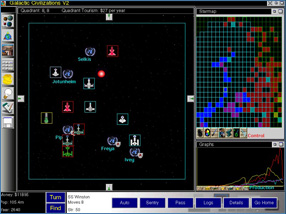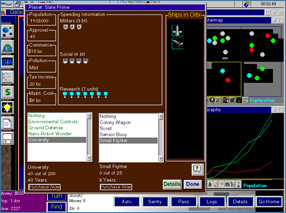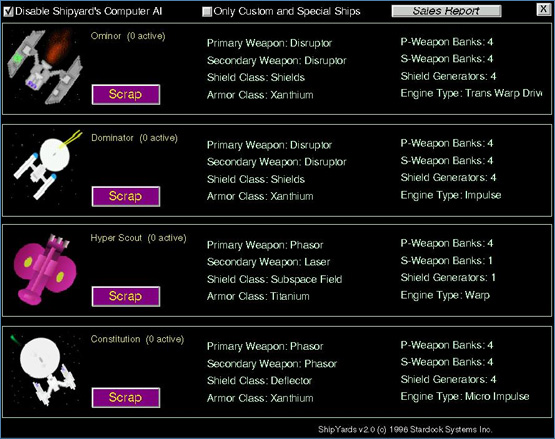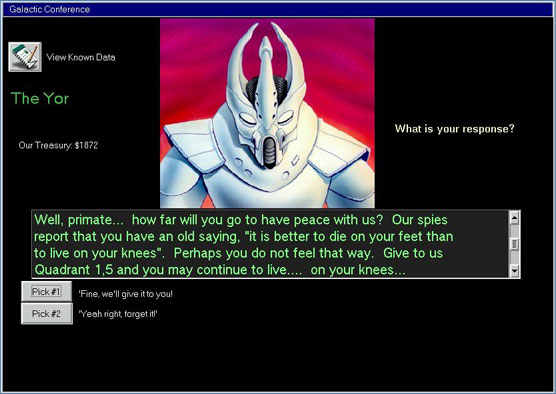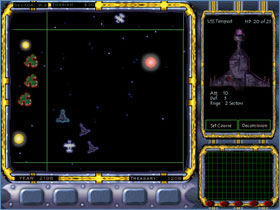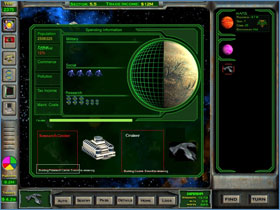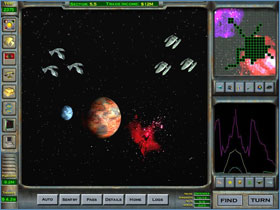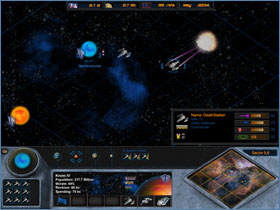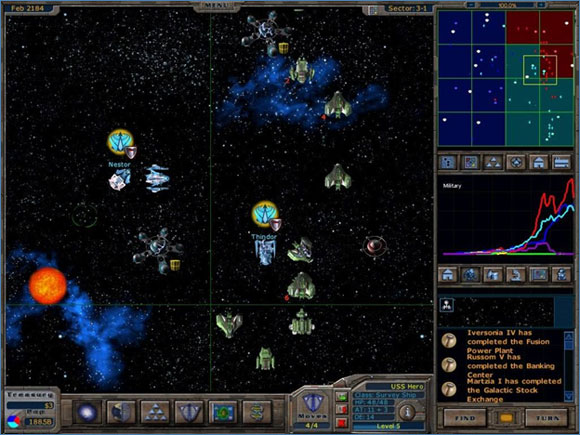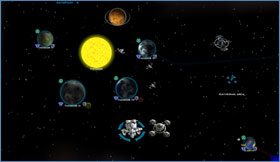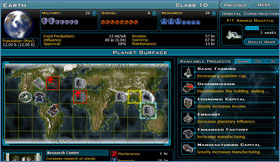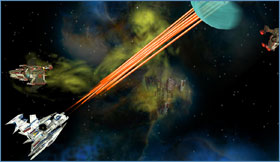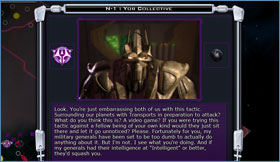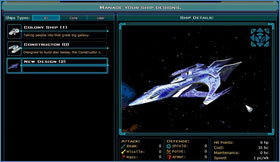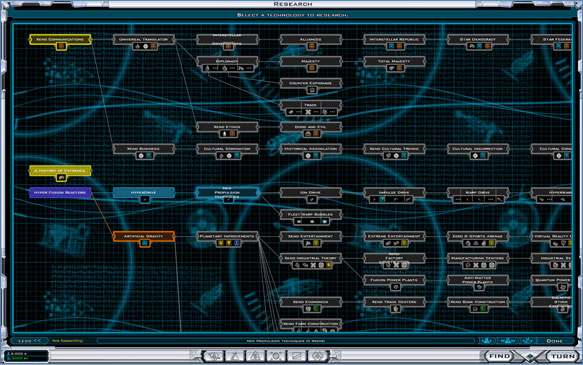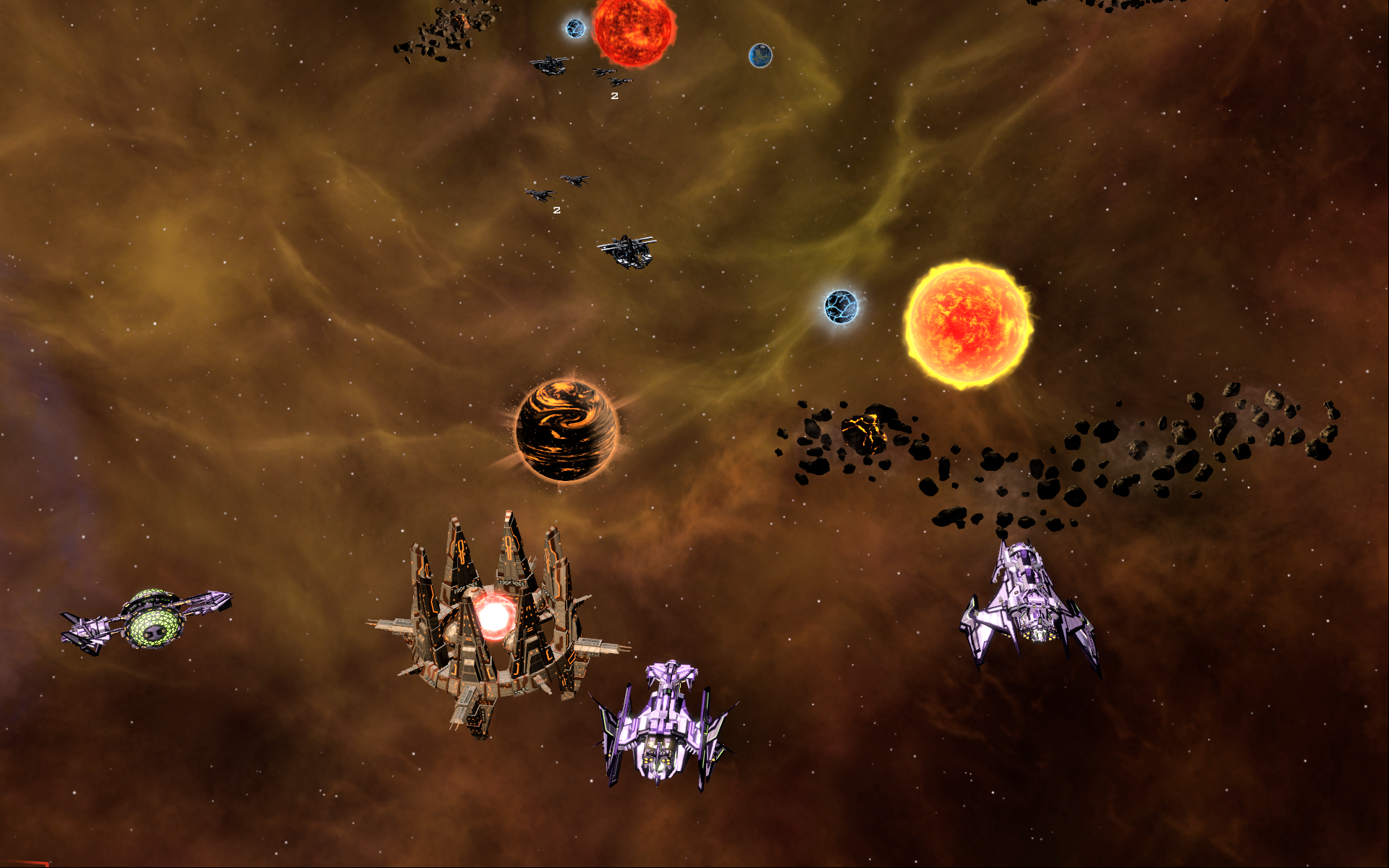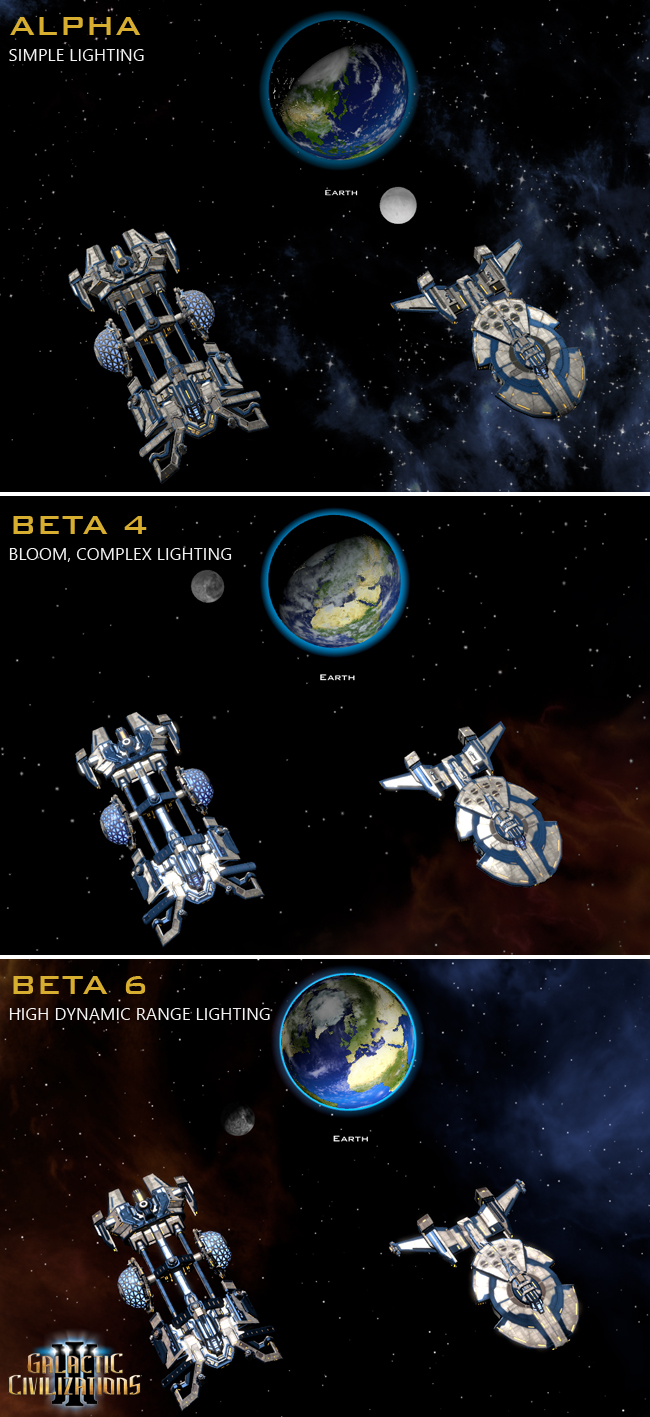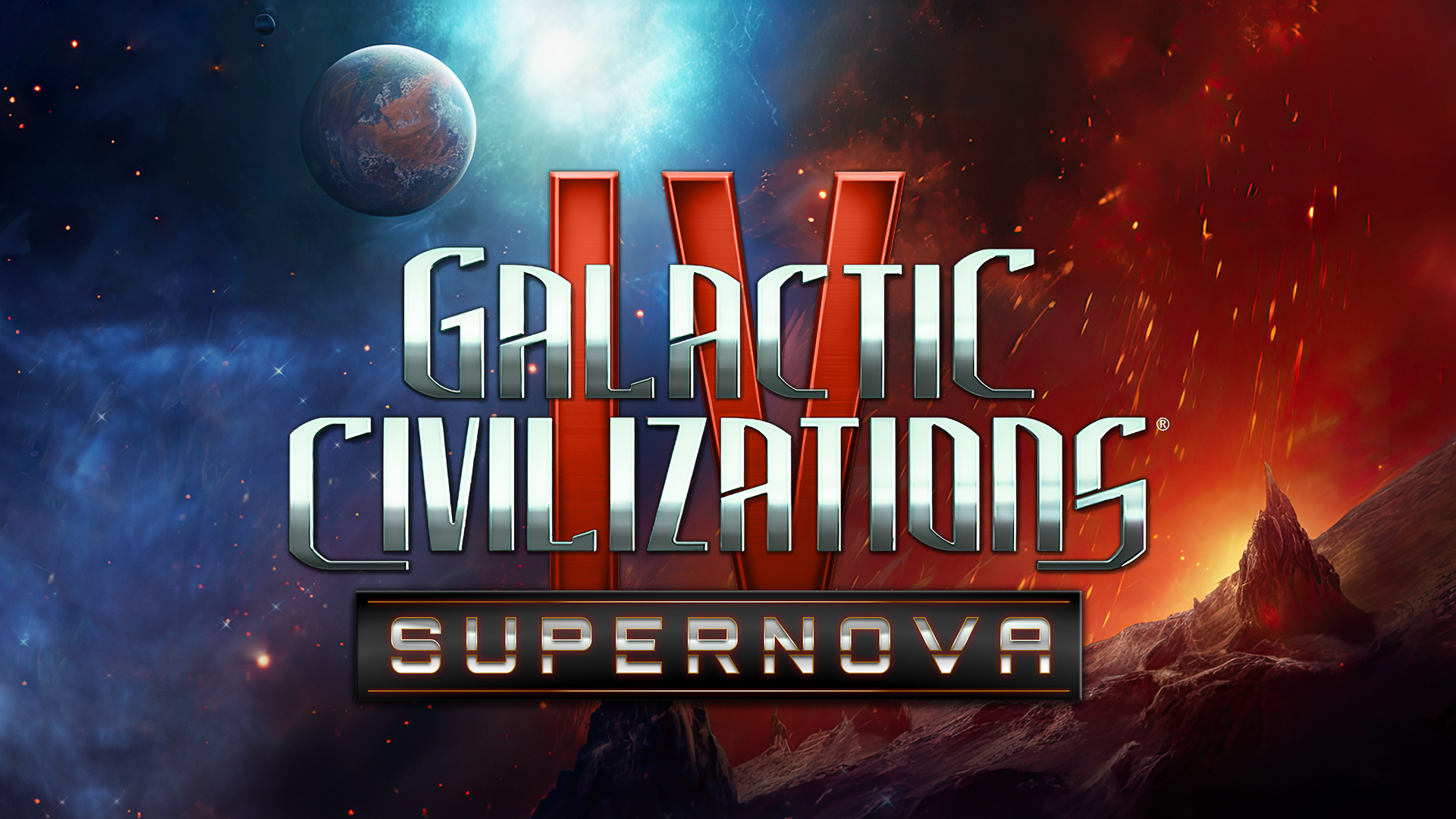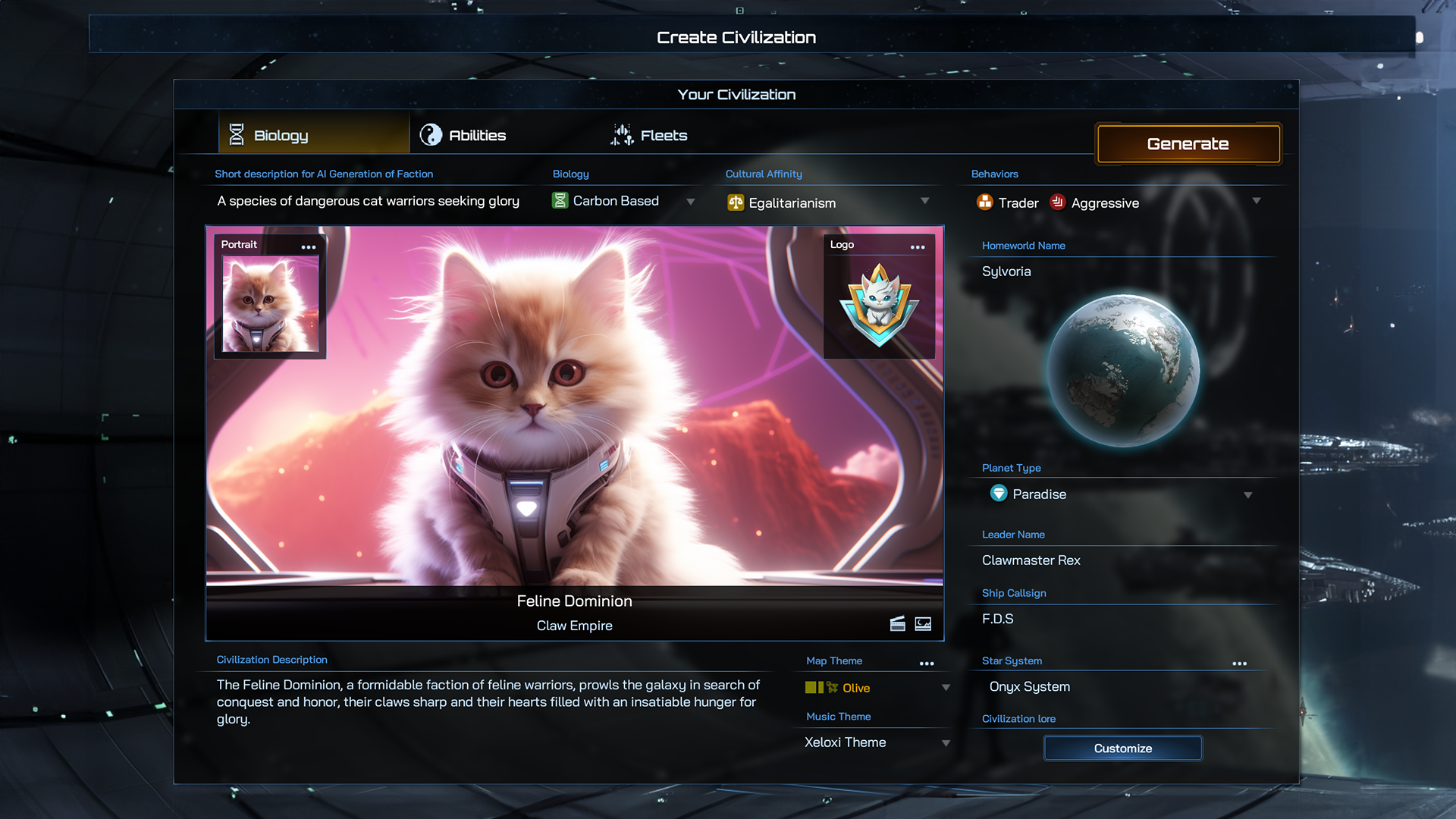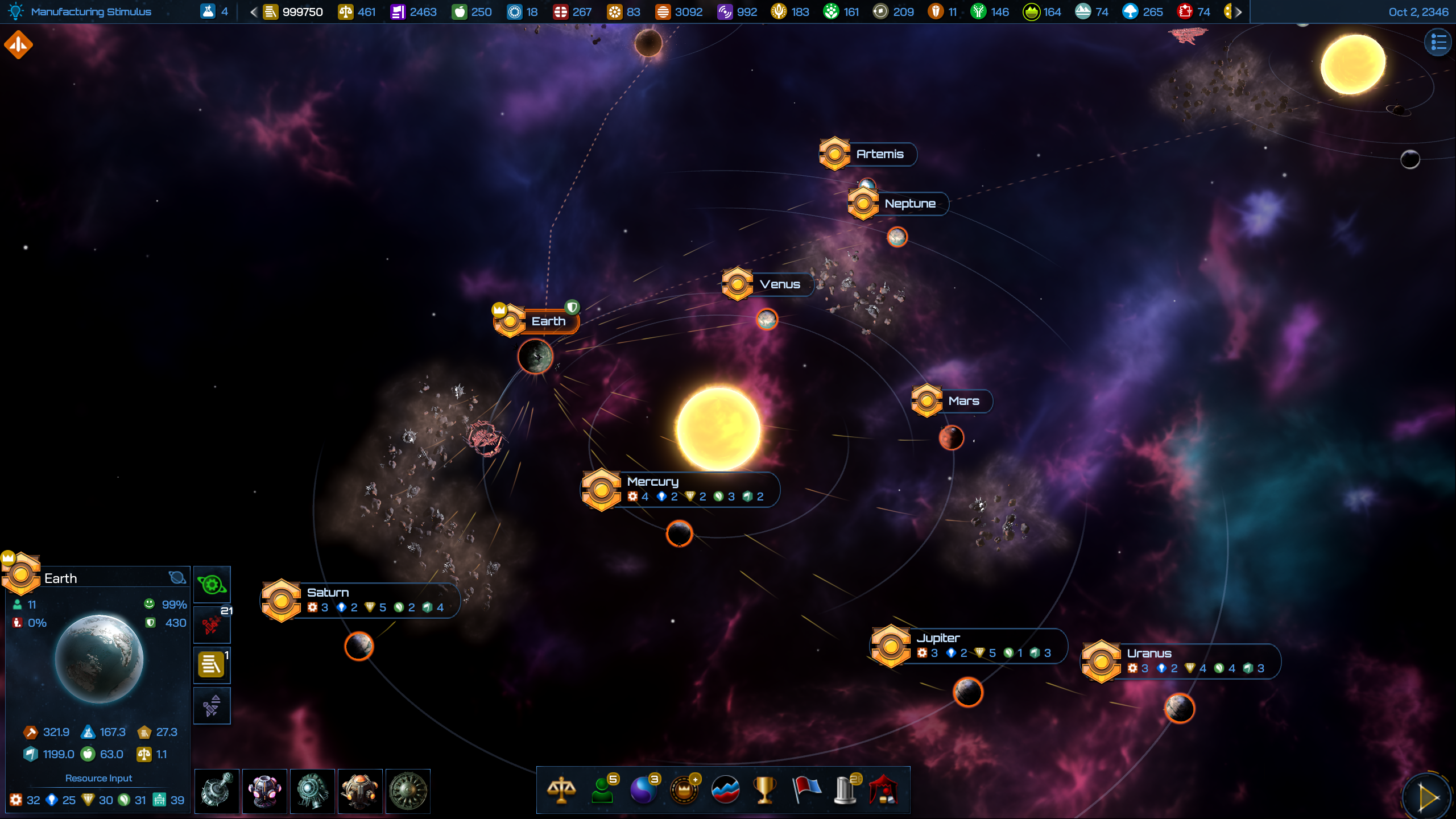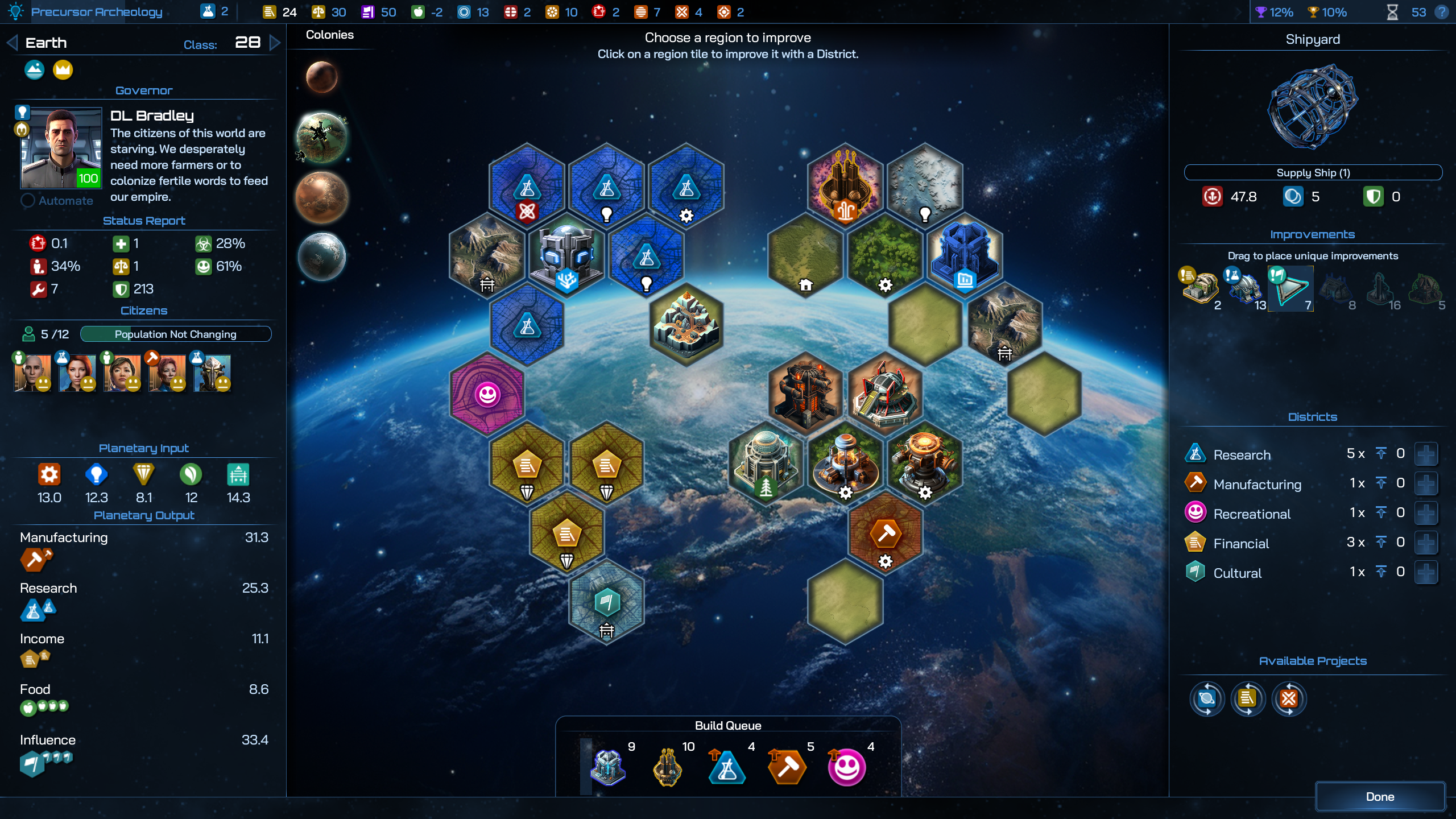Game History: Difference between revisions
No edit summary |
No edit summary |
||
| Line 1: | Line 1: | ||
The ''Galactic Civilizations'' franchise has been around a long time. Here is a brief look at its history. | The ''Galactic Civilizations'' franchise has been around a long time. Here is a brief look at its history. | ||
<h2>Galactic Civilizations For OS/2</h2> | |||
While hanging out on Usenet's comp.sys.ibm.pc.games.strategic in 1992, college student Brad Wardell was just one of many Usenet participants who put together wish lists for their favorite games. Rather than sit in chat rooms all day, Brad decided to do something about his wish list. He would make his own game. One problem – Brad didn't really know how to program (other than some Basic) and was a poor artist. With little money, Brad bought "Teach Yourself C in 21 days" and decided to program the game for IBM's new OS/2 2.x operating system. | While hanging out on Usenet's comp.sys.ibm.pc.games.strategic in 1992, college student Brad Wardell was just one of many Usenet participants who put together wish lists for their favorite games. Rather than sit in chat rooms all day, Brad decided to do something about his wish list. He would make his own game. One problem – Brad didn't really know how to program (other than some Basic) and was a poor artist. With little money, Brad bought "Teach Yourself C in 21 days" and decided to program the game for IBM's new OS/2 2.x operating system. | ||
| Line 22: | Line 15: | ||
File:Intro ss 3 s.jpg | File:Intro ss 3 s.jpg | ||
</gallery> | </gallery> | ||
<h2>Galactic Civilizations 2 For OS/2</h2> | |||
In 1995, Stardock released a sequel to Galactic Civilizations (Galactic Civilizations 2) which improved the production values but was largely the same game. Galactic Civilizations 2 Gold was eventually released with updates and fixes that would be in a patch today; this was during the age where major updates couldn't easily be distributed electronically. | In 1995, Stardock released a sequel to Galactic Civilizations (Galactic Civilizations 2) which improved the production values but was largely the same game. Galactic Civilizations 2 Gold was eventually released with updates and fixes that would be in a patch today; this was during the age where major updates couldn't easily be distributed electronically. | ||
| Line 34: | Line 24: | ||
File:Galcivos2 ss 1 s.jpg | File:Galcivos2 ss 1 s.jpg | ||
</gallery> | </gallery> | ||
<h2>Galactic Civilizations For Windows</h2> | |||
By 1997, OS/2 had clearly lost to Microsoft Windows in the battle for the PC desktop. Stardock began migrating its development efforts to Windows and made a number of small Windows games such as The Corporate Machine. Stardock kept its finger in the game industry pie with projects such as Starcraft: Retribution developed for GT Interactive & Blizzard Entertainment. | By 1997, OS/2 had clearly lost to Microsoft Windows in the battle for the PC desktop. Stardock began migrating its development efforts to Windows and made a number of small Windows games such as The Corporate Machine. Stardock kept its finger in the game industry pie with projects such as Starcraft: Retribution developed for GT Interactive & Blizzard Entertainment. | ||
| Line 60: | Line 47: | ||
As Galactic Civilizations was approaching completion, Atari informed Stardock that Master of Orion 3 would be released near the same time. The two companies cooperated on the release schedule in order for them to not directly compete. Stardock moved its ship date so that Master of Orion 3 could be released first, and axed the Shipyards (ship design feature). In return, every box of Master of Orion 3 came with a coupon promoting the relatively unknown Galactic Civilizations. | As Galactic Civilizations was approaching completion, Atari informed Stardock that Master of Orion 3 would be released near the same time. The two companies cooperated on the release schedule in order for them to not directly compete. Stardock moved its ship date so that Master of Orion 3 could be released first, and axed the Shipyards (ship design feature). In return, every box of Master of Orion 3 came with a coupon promoting the relatively unknown Galactic Civilizations. | ||
<h2>Galactic Civilizations II</h2> | |||
While Galactic Civilizations was a commercial success, its publisher, Strategy First, filed bankruptcy without having paid most of the royalties it owed. Luckily, most of Stardock’s revenue came from its software business and the company was able to fund a sequel without relying on the revenue from the Windows version of Galactic Civilizations. | While Galactic Civilizations was a commercial success, its publisher, Strategy First, filed bankruptcy without having paid most of the royalties it owed. Luckily, most of Stardock’s revenue came from its software business and the company was able to fund a sequel without relying on the revenue from the Windows version of Galactic Civilizations. | ||
| Line 85: | Line 69: | ||
File:Galciv2 ss 7 s.jpg | File:Galciv2 ss 7 s.jpg | ||
</gallery> | </gallery> | ||
<h2>Galactic Civilizations III</h2> | |||
It would take a long while for Stardock to get back to the Galactic Civilizations universe. | It would take a long while for Stardock to get back to the Galactic Civilizations universe. | ||
| Line 116: | Line 97: | ||
File:Beta-progression.png | File:Beta-progression.png | ||
</gallery> | </gallery> | ||
<h2>Galactic Civilizations IV</h2> | |||
Galactic Civilizations IV gave Stardock the perfect opportunity for another major reunion. The Galactic Civilizations II team scattered to the winds after release to either work on other projects or take some maternity leave. Now, though, they were able to bring them all – as well as some new faces! - back together to work on IV. | Galactic Civilizations IV gave Stardock the perfect opportunity for another major reunion. The Galactic Civilizations II team scattered to the winds after release to either work on other projects or take some maternity leave. Now, though, they were able to bring them all – as well as some new faces! - back together to work on IV. | ||
| Line 144: | Line 122: | ||
File:Beta-progression.png | File:Beta-progression.png | ||
</gallery> | </gallery> | ||
<h2>Galactic Civilizations IV: Supernova Edition</h2> | |||
Galactic Civilizations IV: Supernova arrives at a unique moment in strategy game development - notably, at the rise of AI generation technology. Stardock has always been well known for its use of AI going all the way back to the OS/2 version of Galactic Civilizations which debuted in 1993 – 30 years ago. It will come as no surprise that we have integrated AI - in all its forms - into the biggest change to Galactic Civilizations ever: Galactic Civilizations IV: Supernova. We are so excited to share this with you! | Galactic Civilizations IV: Supernova arrives at a unique moment in strategy game development - notably, at the rise of AI generation technology. Stardock has always been well known for its use of AI going all the way back to the OS/2 version of Galactic Civilizations which debuted in 1993 – 30 years ago. It will come as no surprise that we have integrated AI - in all its forms - into the biggest change to Galactic Civilizations ever: Galactic Civilizations IV: Supernova. We are so excited to share this with you! | ||
| Line 171: | Line 146: | ||
File:gc4supernova rel ss09.png | File:gc4supernova rel ss09.png | ||
</gallery> | </gallery> | ||
<h2>Timeline</h2> | |||
1992 - College student Brad Wardell begins writing Galactic Civilizations for OS/2 | 1992 - College student Brad Wardell begins writing Galactic Civilizations for OS/2 | ||
| Line 207: | Line 179: | ||
2023 - Galactic Civilizations IV: Supernova released | 2023 - Galactic Civilizations IV: Supernova released | ||
Latest revision as of 20:28, 5 January 2024
The Galactic Civilizations franchise has been around a long time. Here is a brief look at its history.
Galactic Civilizations For OS/2
While hanging out on Usenet's comp.sys.ibm.pc.games.strategic in 1992, college student Brad Wardell was just one of many Usenet participants who put together wish lists for their favorite games. Rather than sit in chat rooms all day, Brad decided to do something about his wish list. He would make his own game. One problem – Brad didn't really know how to program (other than some Basic) and was a poor artist. With little money, Brad bought "Teach Yourself C in 21 days" and decided to program the game for IBM's new OS/2 2.x operating system.
OS/2 had two features that Windows lacked: multithreading and memory protection. These allowed Brad to make a game with a robust computer AI. While most games forced the user to sit and wait for the computer players to plan and execute their strategies after each player turn, Galactic Civilizations would be multithreaded – its computer players would plan their strategy while the player moved their units. As a result, the computer players were significantly more clever and sophisticated than other games at the time.
Galactic Civilizations was probably the first retail game that made use of multiple threads (the second retail game to make use of multiple threads was called Avarice, also released by Stardock and developed by Dave Pottinger, who went on to become the lead developer of Age of Empires III for Ensemble).
As primitive as Galactic Civilizations for OS/2 might have appeared, at the time, PC games typically were only 320x200 with 256 colors. By contrast, Galactic Civilizations natively supported 1024x768 with 16.8 million colors. Stardock released an expansion for Galactic Civilizations for OS/2 called Shipyards which allowed users to design their own ships.
Galactic Civilizations 2 For OS/2
In 1995, Stardock released a sequel to Galactic Civilizations (Galactic Civilizations 2) which improved the production values but was largely the same game. Galactic Civilizations 2 Gold was eventually released with updates and fixes that would be in a patch today; this was during the age where major updates couldn't easily be distributed electronically.
Galactic Civilizations 2 started to incorporate somewhat better artwork as seen with diplomacy screen.
Galactic Civilizations For Windows
By 1997, OS/2 had clearly lost to Microsoft Windows in the battle for the PC desktop. Stardock began migrating its development efforts to Windows and made a number of small Windows games such as The Corporate Machine. Stardock kept its finger in the game industry pie with projects such as Starcraft: Retribution developed for GT Interactive & Blizzard Entertainment.
Stardock was finally able to revisit Galactic Civilizations in 2001, and it would take an additional two years for the game to be released.
Here’s a mockup for Galactic Civilizations I for Windows:
And this is what it ended up looking like:
As Galactic Civilizations was approaching completion, Atari informed Stardock that Master of Orion 3 would be released near the same time. The two companies cooperated on the release schedule in order for them to not directly compete. Stardock moved its ship date so that Master of Orion 3 could be released first, and axed the Shipyards (ship design feature). In return, every box of Master of Orion 3 came with a coupon promoting the relatively unknown Galactic Civilizations.
Galactic Civilizations II
While Galactic Civilizations was a commercial success, its publisher, Strategy First, filed bankruptcy without having paid most of the royalties it owed. Luckily, most of Stardock’s revenue came from its software business and the company was able to fund a sequel without relying on the revenue from the Windows version of Galactic Civilizations.
The sequel, however, would be published by Stardock and move to a full 3D engine.
Galactic Civilizations II was an immense success. Players enjoyed designing their own ships and seeing how they made out against a devious AI.
The game saw two expansions. The first, Dark Avatar, added asteroid fields, mining and numerous other features to the base game. The second expansion, Twilight of the Arnor, overhauled the graphics engine and provided each civilization with its own unique technology tree and ship parts.
The 3D engine was designed to scale with resolution thanks to heavy use of vector graphics within the game assets. As a result, even today on a 4K monitor, Galactic Civilizations II looks stunning. For example, 2560x1440 was unknown as a gaming resolution during Galactic Civilizations II’s development in 2005. The game’s vector-based UI system (based on Stardock’s own DesktopX technology) could scale to handle it, however. This is most obviously seen with the research tree.
As a result, sales of Galactic Civilizations II have remained high since release, regularly peaking into the Steam top 10 even as recently as 2013.
Galactic Civilizations III
It would take a long while for Stardock to get back to the Galactic Civilizations universe.
After the success of Galactic Civilizations II, its top developers worked on Impulse, a digital distribution platform, while a new generation of developers joined Stardock to work on Twilight of the Arnor and then Elemental: War of Magic.
Following the sale of Impulse to GameStop, the Galactic Civilizations team was reunited. They developed Elemental: Fallen Enchantress and then began work on Galactic Civilizations III. The challenge of creating something new and fresh, yet familiar, fell to 15+ year Stardock veteran Paul Boyer as lead designer.
Many designs were created, some were prototyped, a few even built – and discarded between the beginning of development and the game’s release three years later. Boyer and the rest of the Galactic Civilizations III team experimented with single production queues, radically different tech trees, and much more. Ideology went through many iterations, eventually settling on the 5x5x3 grid you see in-game today.
Visually, Galactic Civilizations III is far beyond its initial alpha release. The team added a much more complex lighting system during beta, then went one further by implementing high dynamic range lighting, which makes everything “pop” much more onscreen by making dark darker and bright brighter.
Due to the expected longevity of Galactic Civilizations III, the new engine is strictly 64-bit and DirectX 11. This is to allow the game to continue to be improved and expanded well into the future.
Galactic Civilizations III was launched on May 14, 2015.
Several expansions have been released, alongside smaller DLC. The first was Mercenaries, which added the Galactic Bazaar, where players could buy unique mercenary ships, and the return of the Arcean and Torian civilizations.
The second expansion, Crusade, was practically a new game, making changes to just about every part of the gameplay, adding the Citizens system and bringing three new civilizations to the game, namely Terran Resistance, Onyx Hive and Slyne.
The third expansion, Intrigue, brought Governments to the game, each having different bonuses and Crises, special events that are navigated through a series of choices that the player makes.
The fourth and so far last expansion, Retribution, added to the game Artifacts, powerful items found on planets that give civilization access to new abilities, Hypergates, powerful gateways that, when linked, allow ships to travel faster, as well as bringing back the Drath Legion and Korath Clan civilizations.
Galactic Civilizations IV
Galactic Civilizations IV gave Stardock the perfect opportunity for another major reunion. The Galactic Civilizations II team scattered to the winds after release to either work on other projects or take some maternity leave. Now, though, they were able to bring them all – as well as some new faces! - back together to work on IV.
For almost 30 years, the Galactic Civilizations series has focused on four major pillars: a simulated universe, rich lore, strong AI opponents, and multiple paths to victory. Galactic Civilizations IV supports this approach through several new and exciting features like:
- Simulated Universe
- Strong AI Opponents
- Rich Lore
- Multiple paths to victory
- Player customization: ships, civilizations, and more
- Over a dozen civilizations to choose from – from humans, to robots, to giant alien bug monsters
- Research new technology from huge tech trees and learn new abilities
- Build up planets to increase manufacturing and research capabilities
- Explore the galaxy and meet new alien civilizations
- Build alliances, fight wars, and invade planets
- Win the game through conquest, research, diplomacy, culture, or prestige (new in IV)
This game is the result of years of thinking about the exciting innovations that have been happening in strategy games in recent years. It incorporates the feedback that has come from both players and reviews to create the ultimate turn-based strategy game experience. As one plays, Stardock hopes they will see that a lot of the requests and great ideas that have come from fans of the genre have made their way into Galactic Civilizations IV.
Galactic Civilizations IV released on 26 April 2022.
Galactic Civilizations IV: Supernova Edition
Galactic Civilizations IV: Supernova arrives at a unique moment in strategy game development - notably, at the rise of AI generation technology. Stardock has always been well known for its use of AI going all the way back to the OS/2 version of Galactic Civilizations which debuted in 1993 – 30 years ago. It will come as no surprise that we have integrated AI - in all its forms - into the biggest change to Galactic Civilizations ever: Galactic Civilizations IV: Supernova. We are so excited to share this with you!
GalCiv IV: Supernova builds on and often time revisits concepts that first appeared in Galactic Civilizations IV: Epic Edition. There are also several new features that have been integrated into the Supernova Edition:
- Infinite Civilizations
- ChatGPT Integration
- Starship Classes for Combat
- Terror Stars
- Technological Inspirations
- Layered Combat System
- Alien Civ Generated Quests
- Orbital Planet Upgrades
Amongst the new innovations in Supernova is AlienGPT, a technology that allows players to describe their own custom civilization and then uses generative AI to create it. Other new features include the Civilization Vault, Cultural Progression, a story-driven campaign, several new canon alien civilizations, a new starship designer, a new battle system and much more.
Galactic Civilizations IV: Supernova was released on October 19th, 2023.
Timeline
1992 - College student Brad Wardell begins writing Galactic Civilizations for OS/2
1993 - Galactic Civilizations Beta 1 released
1994 - Galactic Civilizations released for OS/2
1995 - Galactic Civilizations 2 released
1996 - Galactic Civilizations Gold released
2003 - Galactic Civilizations for Windows released
2004 - Galactic Civilizations: Altarian Prophecy released
2006 - Galactic Civilizations II released
2007 - Galactic Civilizations II: Dark Avatar released
2015 - Galactic Civilizations III released
2016 - Galactic Civilizations III: Mercenaries released
2017 - Galactic Civilizations III: Crusade released
2018 - Galactic Civilizations III: Intrigue released
2019 - Galactic Civilizations III: Retribution released
2022 - Galactic Civilizations IV released
2023 - Galactic Civilizations IV: Supernova released
